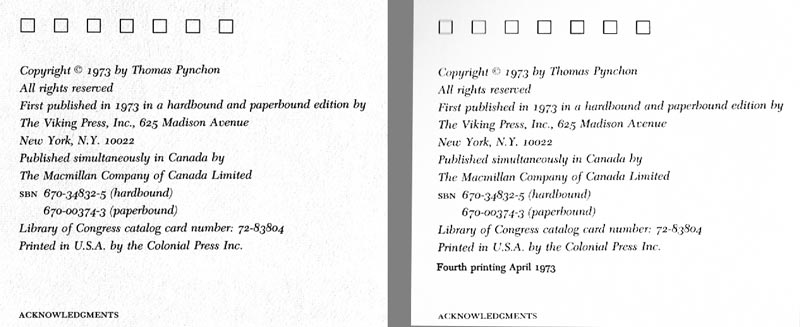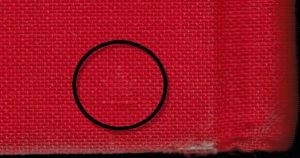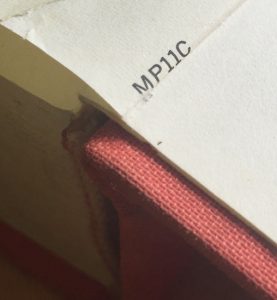For both the original hardcover and paperback versions of Gravity’s Rainbow, the differences between the true first editions and the Book Club editions are fairly subtle, but easy to spot.
When the Viking Press published Thomas Pynchon’s Gravity’s Rainbow in 1973, it simultaneously issued 4,000 hardbacks and 16,000 paperbacks. The reason for publishing the less-expensive paperback ($4.95) at the same time as the hardback ($15.00) was due to the concern of Corlies “Cork” Smith, Pynchon’s editor at the time, that Pynchon’s readership — younger, college-educated, hipper — might balk at coughing up $15 for the novel.
From the Bookforum website: “Pynchon from A to V: Gerald Howard on Gravity’s Rainbow
Now the real problem presented itself: How to publish a seven-hundred-plus-page book at a price that would not be grossly prohibitive for Pynchon’s natural college and post-collegiate audience. V. and The Crying of Lot 49 had each sold more than three million copies in their Bantam mass-market editions. […] According to a letter from Cork Smith [Pynchon’s editor] to Bruce Allen (who reviewed Gravity’s Rainbow for Library Journal but wrote to Viking complaining about the novel’s price), Viking would have had to sell thirty thousand copies at the then unheard of price of $10 just to break even. By comparison, V. and The Crying of Lot 49 had sold about ten thousand copies apiece in hardcover. So how to reach even a fraction of the cash-strapped Pynchon-loving millions? Cork himself hit on the then unique strategy of publishing an original trade-paperback edition at $4.95 and “an admittedly highly priced hardcover edition” at $15, each identical in paper stock and format, differing only in their binding. The gamble: “We also thought that Pynchon’s college audience might, just might, be willing to part with a five-dollar bill for this novel; after all, that audience spends that amount over and over and over again for long-playing records.” The other gamble was with the reviewers, who rarely took paperback fiction seriously, but as Cork wrote, “We feel — as, clearly, you do — that Pynchon cannot be ignored.”
As you may know, both editions in their first printings are quite valuable, particularly the hardcover (and even superior copies of subsequent printings of the first edition), but also the first edition/first printing of the paperback edition. However, the differences between true first editions and the subsequent Book of the Month Club (“BoMC”) (hardcover) and Quality Paperback Book Club (“QPBC”) editions of Gravity’s Rainbow, both published in 1973 (Thomas Pynchon: A Bibliography of Primary and Secondary Sources, Clifford Mead, p.13), are a bit subtle, but easy to identify when you know what to look for.
NOTE ABOUT VALUE: First editions of both the hardcover and paperback editions of Gravity’s Rainbow are only of significant value if they’re first printings, although later printings of both are still pricier than later editions. Printings subsequent to the first printings are clearly indicated on the copyright page, after the line “Printed in U.S.A. by the Colonial Press Inc.” If there is no indication of a subsequent printing, then it’s a first printing (assuming, of course, it meets the other criteria in this article). See the below example:
Both the hardcover and paperback editions went into multiple printings after the first run. BoMC hardcover editions generally go for between $100 – $300, depending on their their condition (VG to Fine). The QPBC paperbacks are not worth that much at all and should only fetch more than, say $10, only if they are misrepresented as first editions.
How to identify a true HARDCOVER first edition of Gravity’s Rainbow
For the hardcover edition, determining its first-edition status is fairly easy. Although the outsides of the dust jacket, front and back, are the same for both the first edition and the BoMC edition, the inner front flaps of the two editions differ; the first editions have the $15.00 price at the top right and the number “0273” at the lower right, whereas neither is present on the BoMC dust jacket inner flap.
Bookseller Ken Lopez, who’s dealt in Pynchon books and Pynchonalia for decades, describes a key difference between the first-edition dust jacket and the BoMC dust jacket:
The one way you can tell the difference between the two editions at a glance is the dust jacket: the publisher’s edition is a glossy, laminated jacket; the BOMC edition uses a coated (but not laminated) paper, which is a bit less shiny and from which the orange color tends to rub much more readily; so if you see a Gravity’s Rainbow with “rubbing” to the jacket, it is almost certain to be a book-club edition, as laminated paper doesn’t really have the color rub off the same way.
In the book itself, the title page and its opposite page (the two pages with the black & white image of clouds in the background) differ in the first edition and the BoMC edition. While the photograph in the first edition is very smooth, in the BoMC edition there is a subtle half-tone grid throughout the image.
On the copyright page — the page after the title page — the dedication to Richard Fariña and the credits that follow begin 1.375″ from the top of the page on the first edition, whereas in the BOMC edition the dedication begins about 2.125″ from the top of the page.
Another little detail: There is a very small (1/4″ square) maple leaf, or sometimes just a square, embossed (aka “blind stamped”) at the bottom right corner of the back boards (i.e., back cover). It’s quite subtle, but it’s there (and quite difficult to capture in a photo!):
Finally, the BoMC edition of Gravity’s Rainbow has, at the bottom of the gutter between the last two blank pages, a tiny alpha-numeric code:
How to identify a true PAPERBACK first edition of Gravity’s Rainbow
As mentioned above, the first-edition/first-printing paperback editions of Gravity’s Rainbow are quite collectible and difficult to find in “fine” condition. Most of the ones I’ve seen have lots of rubbing on the cover as well as fading, particularly on the spine.
On Ebay, I’ve seen very many of the Quality Paperback Book Club (“QPBC”) paperbacks of Gravity’s Rainbow being sold as first editions. I usually write the seller to advise him that his copy is NOT a first edition and that s/he should change the listing to reflect this. I think the frequency of this misrepresentation is due more to ignorance than deceit. Until this article, there has been no guidance to be found on the Internet.
Further confusing things is the fact that neither the BoMC hardcover nor the QPBC paperback editions of Gravity’s Rainbow explicitly state that they are book-club editions. However, like the BoMC hardcovers, the QPBC paperbacks are pretty easy to identify.
Here’s the skinny…
Whereas the price is indicated on both the first-edition hardcovers ($15, at the top-right corner of the front inner flap of the dust jacket) and the first-edition paperbacks ($4.95, at the top-right corner of the front cover), the QPBC editions, like the BoMC hardcovers, have no price indicated anywhere. (Generally, book-club editions don’t have a price on them, an easy tell.)
Whereas on the back cover of the first-edition paperbacks, you’ll see “SBN 670-00374-3” at the bottom right, below the Viking Press address line:
On the back cover of the QPBC edition, instead of the SBN number, you’ll see in the same location a white rectangle below the Viking Press address, with a string of 4 or 5 numbers. I’ve seen different numbers on copies, and I’m not sure to what that number refers.
So there it is! Feel free to ask questions or add info in the Comments section, below.
Further Resources
- Identifying Book Club Editions
- Search Ebay for Gravity’s Rainbow paperback first edition
- Search Ebay for Gravity’s Rainbow hardcover first edition
- Ken Lopez Bookseller — Ken is a very knowledgeable dealer of modern first editions and knows his Pynchon!



What about the first British softcover edition?
Good question, and I’ll soon modify my post to include the UK first edition.
The UK paperback first ed. of Gravity’s Rainbow has only the title and author name on the front cover, nothing else other than the city silhouette and orange sky with spiral blaze of light.
The back cover has the price, ISBN # and cover credit, in the top left corner, and, centered just above the city silhouette, three quotes.
Hope this helps!
I have a copy of Gravity’s Rainbow which is highly unusual and has been very hard to identify but I think I now understand what it appears to be. It is a withdrawn library book with all of the bad points of being such, plus having been possibly rebound. I believe it is (based on the points in your article) a First Edition, First Printing hardcover horribly mangled but strangely presentable. The cover has been cutdown about 1/8th of an inch top and bottom. It has then been laminated to white boards which are either the book’s original boards or the book itself has been rebound. (What color are the boards in a First, First?) This resulted in a sort of band of white along the top and bottom of the covers and spine. On the back cover is the ISBN for the hardcover edition. The clouds are smooth without a noticeable (to the naked eye) halftone grid. The dedication to Farina is at the hardcover position. There is no BOMC number between the blank pages. The front and back covers are bright but the spine is quite faded except for a small, square area where it must have carried a Dewey Decimal or other library shelving label. Pages are a little yellowed but no rips or tears. Library idiocies include a withdrawn stamp and a control number on the title page as well as a lightly embossed library seal. On the copyright page is another small, handwritten control number. The last two blank pages carry the library stamp and on the final page the library pocket. It looks good on the shelf in my very modest Pynchon collection and I can’t help wondering if it is indeed a First, First? Any idea? I have no idea how to attach a picture(s) to this but could email a few if needed. Thanks!
Sounds like what you describe, i.e., a library copy of the first edition of Gravity’s Rainbow. If there’s no mention of a subsequent printing in the copyright block, then it’s a first printing. As for the color of the boards, they’re white on the inside and orange cloth on the outside. The value of your copy, with its library- and sunlight-inflicted damage, is significantly diminished, maybe a couple hundred bucks. But it’s always cool to have a first edition first printing of such a monumental work, as there were only 4,000 printed on the first run.
I have a 1st edition in mint condition with original sales receipt.?
Congratulations!
I have a hardback that states printed in by Colonial inc 1973
April 4th printing
Is this a first edition?
If it meets the other conditions in the article to ensure it’s not a book club edition, then, yes, it’s a first edition, 4th printing.
I have a copy that looks like a BOMC copy.
No Price or number on the front inner of the dust jacket – check
Half-tone screen – check
Richard Farina top indent – check
It has (MP4C) stamp on the end papers – check
Here is an undescribed feature. It has the number 0365 on a white ground just below the word ‘New York’ on the back dust jacket.
Is this a regular BOMC edition?
As this article states quite clearly, yes.
Does the 4,000 count of the first printing include the BOMC or are they additional? If so, how many 1st ed,1st print BOMC were printed?
No, I don’t believe the 4000 count includes the BoMC edition which was a separate product published later. I have no idea about the quantity of the BoMC edition.
My father has in his collection a paperback copy of Gravity’s Rainbow that meets your criteria for being a first edition. It has the SBN on the back cover, price on cover etc. But how does one know if it is first or second printing …or was there only one printing like this? Thank you for your help, have so many other books to deal with as well.
Thanks Debbie. As the article clearly states:
First editions of both the hardcover and paperback editions of Gravity’s Rainbow are only of significant value if they’re first printings, although later printings of both first editions are still pricier than later editions. However, the second hardcover edition (1991), with the “sunset” dust jacket, is fairly pricey, especially if there’s no remainder mark on the bottom text block. Printings subsequent to the first printings are clearly indicated on the copyright page, after the line “Printed in U.S.A. by the Colonial Press Inc.” If there is no indication of a subsequent printing, then it’s a first printing (assuming, of course, it meets the other criteria in this article).
And just look at the examples. This should clear it up for you.
I was trying to track down the meaning of the number in the small white box on my first printing of GR in paperback. Thank to your page I now know the book is from the Quality Paperback Book Club run. However, what is startling to me is your example image:
https://thomaspynchon.com/wp-content/uploads/2016/05/GR-PB-BookClub-Back.jpg
The copy right here next to me is either another 00014, or is the 00014 seen as your jpg image. Any thoughts? I did see one via website hunting with a four-digit 0365.
The 0365 I found apparently belongs to a Nathan Gaddis, based on his Twitter ID. But in the comments posted here I see another person has written to you that he has 0365. It appears these numbers were reused to some degree?
No, the “00014” isn’t #14 of a larger run. It’s just an identifier, although I’m not sure what it identifies! If the “0365” example you found has that number in the white bar, then it indicates something else but I’m not sure what. I am sure, however, it’s NOT a first edition. I’ve little interest in getting into the weeds regarding BoMC editions. If you do, go for it and post your findings here!
Thank you for the info. Here’s the 0365 I found: https://x.com/nrgaddis/status/598122855209959424
I’m not looking to wander into those weeds either, as I’m more focused on finally getting through this book for the first time (nearing halfway after a month and enjoying it). I’ll just accept my 00014 as another curious aspect. Thanks again!
There are a couple of clues that indicate the BOMC edition was published at Maple Press in Pennsylvania rather than at Colonial Press in Massachusetts, where the first edition was printed. At the time BOMC editions were produced using duplicated components—film flats and binder’s dies—created after the originals in conjunction with book publisher. The two clues are the maple leaf blind stamp (each contracted BOMC printer/binder had a different distinctive blind stamp) and the film flat signature code with MP11C used during the gathering process.
Thanks for this info, Alan. You seem quite knowledgeable regarding this stuff!